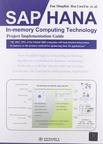SAP HANA内存计算技术项目实战指南
2012-11
清华大学出版社
潘明惠,徐莲荫 等 著
366
Based on HANA project experience with 36 validation scenarios of in-memory computing technology accumulated by large power companies, this book consisting of 12 chapters, describes in a detailed way how to use SAP HANA to meet query and analysis needs from business application systems; how to choose business and capture real-time data for decision-making analysis and business information query under the underserved circumstance; how to make use of a variety of modelling tools offered by HANA for modelling; how to choose a presentation tool to complete analysis report; how to obtain the balance between models and analytical tools for better analytical performance; how to deploy the roll-out; how to manage, run and maintain the system after the roll-out; and the management priorities of the HANA executive project.
Pan Minghui is CIO of Liaoning Electric Power Company, senior engineer with Ph.D. degree, adjunct professor of Harbin Institute of Technology, outstanding expert of SGCC, member of Liaoning Provincial Committee of Experts on information technology, and member of Experts on major National Scientific and Technological Project. Dr. Pan has won 1 First National Scientific and Technological Progress Prize, 1 Second Prize and 19 other provinces and ministeral level awards. He has published 42 scientific papers and Engineering of Information Network Security Theories and Applications, Informationlization Engineering Theories and Applications, 200 Questions and Answers for Informationlization Engineering Technology, Introduction to Knowledge of Computer and Information Network, Experience of Electric Power Industry, SAP HANA Project Implementation Guide and SAP ERP Exam Questions Inventory 7 books.
Chapter 1 IntroductionChapter 2 Evolution of Computer and Origin of In-memory Computing Technology2.1 Evolution of Computer2.1.1 Changes of Generations of Computer2.1.2 Development of Processor2.1.3 History of Memory2.2 Origin of In-memory Computing Technology2.2.1 Business Needs2.2.2 Development of Hardware.2.2.3 Software Technology Innovation2.3 ConclusionsChapter 3 Features of SAP HANA In-memory Computing Technology3.1 Profiles of Main In-memory Computing Technology Products3.1.1 SAP HANA3.1.2 Oracle Exalytics3.1.3 Oracle Times Ten3.1.4 IBM Solid DB3.2 Characteristics of SAP HANA memory technology3.2.1 Efficient Parallel Processing Mechanism3.2.2 Memory-based Efficient Data Read and Process3.2.3 Efficient Data Compression to Optimize Memory Utilization3.2.4 Row-column Storage Mixed-mode3.2.5 Virtual Modelling to Reduce Data Redundancy3.2.6 Data-intensive Computing at the Database Layer3.2.7 Other Characteristics of SAP HANA3.3 ConclusionsChapter 4 Basic Knowledge of SAP HANA ln-memory Computing Technology Application4.1 SAP HANA Appliance Architecture4.1.1 HANA In-memory Computing Engine4.1.2 HANA Studio4.1.3 Presentation Layer of HANA4.1.4 HANA-Enabled Data Sources4.2 SAP HANA Applicable Hardware Servers4.2.1 SAP HANA Applicable Platform Requirements4.2.2 Explanation of Adaptability of SAP HANA to P7704.2.3 Instruction of Support of HANA to Superdome and rx864.2.4 Conclusions of Analysis on SAP HANA Applicable Platform4.3 SAP HANA Studio (HANA Studio)4.3.1 System Requirements4.3.2 Enabling Platforms4.3.3 Functions of HANA Studio4.4 SAP HANA Reporting Presentation Tools4.4.1 HANA Database Access Interfaces4.4.2 HANA Reporting Presentation Tools4.5 SAP HANA Application RestrictionsChapter 5 Data Extraction Mechanism of SAP HANA5.1 Trigger-Based Replication-SLT Data Synchronization5.1.1 Initialization Import5.1.2 Incremental Updating5.1.3 SLT Data Synchronization Features5.2 ETL-Based Replication-DS Data Synchronization5.2.1 Data Service Modelling Tools5.2.2 Data Initialization Import and Incremental Updating5.2.3 Features of DS Data Synchronization5.2.4 Components Required by ETL-Based Data Synchronization5.3 Log-Based Replication-SRS Data Synchronization5.3.1 Data Initialization Import and Incremental Updating5.3.2 Features of SRS Data Synchronizatio5.3.3 Components ofLog-Based Data Synchronization5.4 Comprehensive Comparison ofThree Data Replication TechnologiesChapter 6 System Security and Privilege Management of SAP HANA6.1 User Management and Authentication6.1.1 User Management Tools and Validation6.1.3 Standard Users and Roles6.2 Authorization6.2.1 Authorization Concepts……Chapter 7 SAP HANA Modelling TechniquesChapter 8 Applications of SAP HANA In-memory Computing TechnologyChapter 9 SAP HANA PoC Project Conducted by LNEPCChapter 10 Project Management of SAP HANA ImplementationChapter 11 SAP HANA System BuildingChapter 12 Experience and Recommendations on SAP HANA SystemReferenceAppendix 1 Manual for HANA System Server InstallationAppendix 2 Manual for Installation of HANA Studio and BO 4.0 ClientAppendix 3 Manual for HANA-SLT data provisioning trainingAppendix 4 Manual for HANA Modelling OperationAppendix 6 Manual for System Deployment-Production System Preparation
